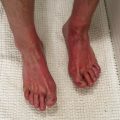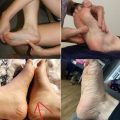Piriformis syndrome is a neuromuscular disorder that occurs when the piriformis muscle compresses the sciatic nerve, causing pain and other symptoms in the buttocks and legs. The piriformis muscle is a small, pear-shaped muscle that is located deep in the buttock region. Its main function is to help rotate the hip and stabilize the pelvis during walking and other activities.
The piriformis muscle runs diagonally from the sacrum (the triangular bone at the base of the spine) to the hip joint. The sciatic nerve is the largest nerve in the body and runs from the lower back down through the buttocks and legs. In some people, the sciatic nerve passes through or under the piriformis muscle. When the muscle becomes tight or inflamed, it can put pressure on the sciatic nerve, leading to pain, numbness, and tingling in the buttocks and legs.
History
The first description of piriformis syndrome can be traced back to 1928 when Yeoman published a paper describing a syndrome of sciatica caused by the piriformis muscle. However, the condition did not become widely recognized until the 1940s and 1950s when several other researchers reported cases of sciatic pain caused by the piriformis muscle.
One of the most influential researchers in the field of piriformis syndrome was Dr. Guy Voyer, a Canadian osteopath who first described a technique for diagnosing and treating the condition in the 1970s. Dr. Voyer’s technique, called “piriformis syndrome correction,” involves a series of manual manipulations to the piriformis muscle to release tension and reduce pressure on the sciatic nerve.
In the 1980s and 1990s, several studies were conducted to investigate the prevalence and causes of piriformis syndrome. These studies helped to establish piriformis syndrome as a distinct clinical entity and led to the development of new diagnostic and treatment methods.
Today, piriformis syndrome is recognized as a relatively common cause of sciatica and other types of hip and buttock pain. It is estimated to affect between 6% and 36% of the population, with women being more commonly affected than men.
Despite advances in our understanding of the condition, there is still some debate among healthcare professionals about the best methods for diagnosing and treating piriformis syndrome. Some experts advocate for a conservative, non-invasive approach that includes physical therapy and stretching exercises, while others recommend more aggressive treatments such as injection therapy or surgery.
Causes
Piriformis syndrome can be caused by a variety of factors, including:
- Trauma or injury to the buttocks
- Overuse or repetitive strain injury
- Poor posture
- Sitting for long periods of time
- Pregnancy and childbirth
- Anatomic abnormalities
- Tightness or weakness in other muscles
- Arthritis or degenerative changes in the spine
Symptoms
The most common symptom of piriformis syndrome is pain in the buttocks that may radiate down the back of the leg. The pain is often described as a dull ache or sharp, shooting pain. Other symptoms may include:
- Numbness or tingling in the buttocks, thigh, or leg
- Difficulty sitting or standing for prolonged periods
- Pain when walking up stairs or hills
- Pain during or after exercise
- Reduced range of motion in the hip joint
Diagnosis
Diagnosis of piriformis syndrome is often based on a physical exam and a review of the patient’s symptoms and medical history. The doctor may also order imaging tests, such as an X-ray, MRI, or CT scan, to rule out other conditions that may be causing the symptoms.
The goal of treatment is to relieve pain, reduce inflammation, and restore normal function. While there is no quick fix for piriformis syndrome, there are several strategies including piriformis syndrome exercises that can help speed up the healing process.
- Stretching: Stretching is one of the most effective ways to relieve tension in the piriformis muscle. Gentle stretching exercises can help increase flexibility and range of motion in the affected area, reducing pain and discomfort. Some of the recommended stretches for piriformis syndrome or piriformis syndrome exercises
include:
- Seated figure-four stretch: Sit on the floor with your legs straight out in front of you. Cross your left ankle over your right knee and gently pull your left knee toward your chest. Hold the stretch for 20-30 seconds, then switch sides.
- Pigeon pose: Begin on all fours, then slide your right knee forward so it’s behind your right wrist. Stretch your left leg back behind you. Lower yourself down onto your forearms, and hold the stretch for 20-30 seconds. Repeat on the other side.
- Standing hamstring stretch: Stand with your feet shoulder-width apart. Hinge forward at the hips and reach toward your toes, keeping your knees straight. Hold the stretch for 20-30 seconds.
- Massage: Massaging the piriformis muscle can help release tension and relieve pain. You can use a foam roller or a massage ball to massage the muscle. Lie on your back with your knees bent and place the foam roller or massage ball under one buttock. Roll back and forth slowly, applying pressure to the affected area. Repeat on the other side.
- Ice and heat therapy: Applying ice to the affected area for 20 minutes at a time, several times a day, can help reduce inflammation and pain. After a few days, switch to heat therapy to help relax the muscle. Apply a heating pad or warm towel to the affected area for 20-30 minutes at a time.
- Rest: Avoid activities that aggravate your symptoms, such as running or sitting for long periods. Instead, rest and allow your body to heal. Try to find a comfortable position to rest in, such as lying on your side with a pillow between your legs.
- Physical therapy: A physical therapist can help you develop a personalized treatment plan that includes stretching and strengthening exercises, as well as manual therapy techniques. They may use techniques such as myofascial release or trigger point therapy to help release tension in the piriformis muscle.
- Pain medication: Over-the-counter pain medications such as ibuprofen can help relieve pain and inflammation. Consult with your doctor before taking any medication.
- Injections: In severe cases, your doctor may recommend injections of corticosteroids to reduce inflammation and pain. These injections can provide quick relief, but should only be used as a last resort.
It’s important to consult with a healthcare professional before trying any of these tips to ensure they are safe and appropriate for your specific situation. Remember that healing piriformis syndrome can take time, and it’s important to be patient and consistent with your treatment plan.





